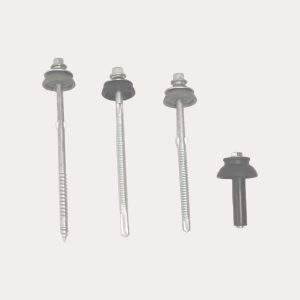Safety should always be the top priority in the sheet roofing industry. Whether you’re a professional contractor, a DIY enthusiast, or a supplier of roofing materials and accessories, maintaining a secure work environment is crucial. In this blog post, we’ll discuss the importance of safety in the sheet roofing industry and offer valuable tips and guidelines to keep everyone involved safe and sound.
1. Understanding the Risks
Sheet roofing installation and maintenance come with a unique set of risks, which include:
- Falls: The primary risk in the roofing industry is the potential for falls, often from significant heights. These accidents can result in severe injuries or even fatalities.
- Weather Conditions: Roofing work is often conducted outdoors, making workers vulnerable to adverse weather conditions, such as high winds, rain, or snow, which can impact stability and visibility.
- Tool and Equipment Hazards: The use of various tools and equipment, such as power tools and ladders, poses risks if not handled properly.
- Material Handling: Heavy roofing materials, like sheet metal, can cause injury when lifting or carrying them.
- Electricity: Working near electrical systems and equipment increases the risk of electrical shock or fire.
2. Safety Equipment and Personal Protective Gear
To minimize risks in the sheet roofing industry, the use of safety equipment and personal protective gear is non-negotiable. Here are some key items:
- Fall Protection Systems: This includes harnesses, lanyards, lifelines, and anchor points. Always use these systems when working at heights.
- Hard Hats: Protect your head from falling objects.
- Safety Glasses or Goggles: Shield your eyes from debris, sparks, and other hazards.
- Ear Protection: Guard against the potentially damaging noise levels generated by power tools.
- Respirators or Dust Masks: Prevent the inhalation of harmful fumes or particulate matter.
- Gloves: Protect your hands from sharp metal edges, chemicals, and extreme temperatures.
- Safety Footwear: Slip-resistant, steel-toed boots provide stability and protect your feet.
- High-Visibility Clothing: Especially important when working in low-light conditions or areas with vehicular traffic.
3. Proper Training and Certification
No one should engage in sheet roofing work without the proper training and, if necessary, certification. Ensure that all workers, whether they are contractors, employees, or even DIY enthusiasts, are trained on safety procedures and best practices, as well as the correct use of tools and equipment. Certification may be required for specific tasks, like welding or operating certain machinery.
4. Safe Ladder and Scaffold Usage
Falls from ladders and scaffolds are among the most common roofing accidents. To use these tools safely:
- Inspect ladders and scaffolds before each use to ensure they are in good condition.
- Set up ladders on stable, level ground and secure them at the top and bottom.
- Use scaffold platforms with guardrails and toe boards.
- Maintain a 3-point contact when ascending or descending ladders.
5. Weather Considerations
Weather can significantly impact the safety of roofing work. Always consider the following:
- Avoid working on a roof in icy, wet, or windy conditions.
- Use caution during extreme heat to prevent heat-related illnesses.
- Keep the work area clear of snow and ice to prevent slipping hazards.
- Utilize weatherproof covers or tarps to protect the work area from rain.
6. Tool and Equipment Safety
Power tools and equipment play a crucial role in roofing work, but they can also be dangerous if not handled correctly:
- Always read and follow the manufacturer’s instructions for tool and equipment use.
- Inspect tools and equipment regularly for wear and tear and replace damaged items.
- Wear appropriate personal protective gear when using power tools, especially eye and ear protection.
- Keep tools and equipment clean and well-maintained.
7. Material Handling Safety
When handling heavy roofing materials, such as metal sheets, practice these safety guidelines:
- Use proper lifting techniques, including bending at the knees, keeping the load close to your body, and lifting with your legs rather than your back.
- Consider using lifting equipment, such as hoists or cranes, for particularly heavy materials.
- Store materials properly to prevent accidents and injuries due to falling objects.
8. Electrical Safety
Working near electrical systems or equipment requires extra precautions:
- De-energize electrical systems whenever possible before starting work.
- Inspect cords and equipment for damage before use.
- Use ground fault circuit interrupters (GFCIs) to protect against electrical shock.
- Never work on electrical systems without proper training or certification.
9. Fire Safety
Roofing work can involve hot work processes like welding or torching. To prevent fires:
- Have fire extinguishers readily available and ensure all workers know how to use them.
- Clear the work area of flammable materials, and use fire-resistant barriers when necessary.
10. Regular Safety Meetings and Communication
Fostering a culture of safety in the sheet roofing industry requires open communication and regular safety meetings. These meetings should address current and potential hazards, provide updates on safety procedures, and encourage workers to share their concerns and suggestions.
11. Emergency Response Plan
Every roofing site should have a well-documented emergency response plan. This plan should cover procedures for handling injuries, fires, and other emergencies. Ensure that all workers are familiar with the plan and know the location of first aid kits, fire extinguishers, and emergency exits.
12. Site-Specific Safety Assessment
Before starting any roofing project, perform a site-specific safety assessment. Identify potential hazards, develop a plan to mitigate them, and communicate the plan to all workers. Ensure that everyone knows how to respond in the event of an emergency.
13. Regular Inspections
Frequent inspections of the work site, equipment, and safety measures are essential. These inspections should be carried out by competent individuals who can identify potential issues and recommend corrective actions.
14. Stay Informed and Updated
Keep up to date with safety regulations, industry standards, and advancements in safety practices. The roofing industry, like any other field, evolves, and staying informed is key to maintaining a safe work environment.
In conclusion, safety in the sheet roofing industry is paramount. The risks associated with roofing work are real, but with proper training, personal protective gear, and a strong safety culture, you can minimize these risks and create a secure work environment. Whether you’re a roofing professional, a supplier of roofing materials and accessories, or a DIY enthusiast, remember that safety should always be your top priority. By taking the necessary precautions and fostering a culture of safety, you can ensure that everyone involved in the sheet roofing industry stays safe and well-protected.




